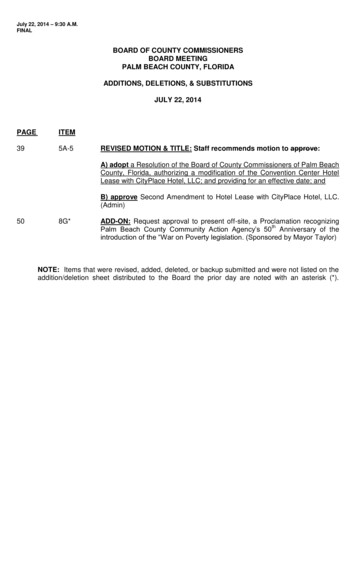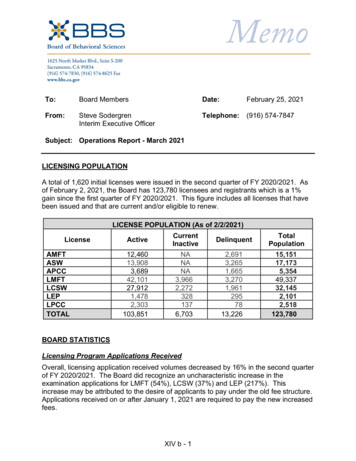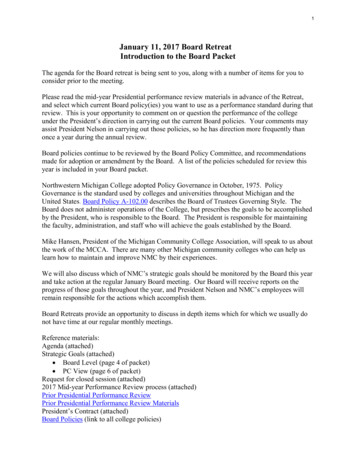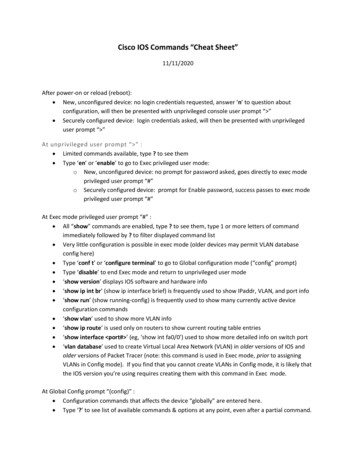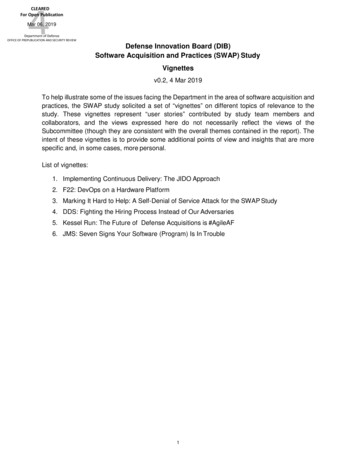
Transcription
CLEAREDFor Open PublicationMar 06, 2019Department of DefenseOFFICE OF PREPUBLICATION AND SECURITY REVIEWDefense Innovation Board (DIB)Software Acquisition and Practices (SWAP) StudyVignettesv0.2, 4 Mar 2019To help illustrate some of the issues facing the Department in the area of software acquisition andpractices, the SWAP study solicited a set of “vignettes” on different topics of relevance to thestudy. These vignettes represent “user stories” contributed by study team members andcollaborators, and the views expressed here do not necessarily reflect the views of theSubcommittee (though they are consistent with the overall themes contained in the report). Theintent of these vignettes is to provide some additional points of view and insights that are morespecific and, in some cases, more personal.List of vignettes:1. Implementing Continuous Delivery: The JIDO Approach2. F22: DevOps on a Hardware Platform3. Marking It Hard to Help: A Self-Denial of Service Attack for the SWAP Study4. DDS: Fighting the Hiring Process Instead of Our Adversaries5. Kessel Run: The Future of Defense Acquisitions is #AgileAF6. JMS: Seven Signs Your Software (Program) Is In Trouble1
Vignette #1 – Implementing Continuous Delivery: The JIDO ApproachForrest J. Shull, SWAP Study Teamv0.1, 6 Feb 2019One theme that emerges from the work in this study is that DoD certainly does have successesin terms of modern, continuous delivery of software capability; however, in too many cases, thesesuccesses are driven by heroic personalities and not supported by the surrounding acquisitionecosystem. In fact, in several cases the demands of the rest of the ecosystem cause friction that,at best, adds unnecessary overhead to the process and slows the delivery of capability. The JointImprovised Threat Defeat organization (JIDO), within the Defense Threat Reduction Agency, is acompelling example.JIDO describes itself as “the DoD’s agile response mechanism, a Quick Reaction Capability(QRC) as a Service providing timely near-term solutions to the improvised threats endangeringU.S. military personnel around the world1.” As such, the speed of delivery is a key successcriteria, and JIDO has had important improvements in this domain as referenced by the additional(following) JIDO vignette in this series. Central to accomplishing these successes has been theadoption of a DevSecOps solution along with a continuous Authorization to Operate (ATO)process, which leverages the automation provided by DevSecOps to quickly assess securityissues.At least as important as the tooling are the tight connections that JIDO has enabled among thestakeholder groups who have to work together with speed to deliver capability. JIDO haspersonnel embedded in the user communities associated with different COCOMs, referred to asCapability Data Integrators (CDIs). These personnel are required to be familiar with the domain,familiar with the technology, and forward-leaning to envision technical solutions to help warfighteroperations. Almost all CDIs have prior military experience and are deployed in the field, movingfrom one group of users to another, helping to train them on the tools that are available andunderstanding at the same time what they still need. CDIs have tight reach back to JIDO, and areable to identify important available data that can be leveraged by software functionality and canbe developed with speed through the DevSecOps pipeline.JIDO has also focused on knocking down barriers among contractors and government personnel.JIDO finds value in relying on contract labor that can flex and adapt as needed to the technicalwork, with effort spent on making sure that the mix of government personnel and multiplecontractor organizations can work together as a truly integrated team. To accomplish this, JIDOhas created an environment with a great deal of trust between government and contractors. Thereare responsibilities that are inherently governmental, and tasks that can be delegated to thecontractor. Finding the right mix requires experimentation, especially since finding the personnelwith the right skillset on the government side is difficult.Despite these successes bringing together stakeholders within the JIDO team, there aresometimes substantial difficulties working within the rest of the acquisition ecosystem, since onmany dimensions the agile/DevSecOps approach does not work well with business as usual. Forexample, there have been instances where the Services or the Joint Chiefs push back on1 JIDOSecDevOps Concept of Operations, v12
solutions that were created to address requirements from the field. Thanks to the CDIs, JIDO cancreate a technical solution that answers identified requirements from warfighters in the field, butthat does not mean it will get approval for deployment. There is a mismatch and potential formiscommunication when the organizations that control deployment do not own the requirementsthemselves.Also, because JIDO operates in an agile paradigm in which requirements can emerge and get reprioritized, it is difficult for them to justify budget requests upfront in the way that their commandchain requires. JIDO addresses this today by creating notional, detailed mappings of functionalityto release milestones. Since a basic principle of the approach is that capabilities being developedcan be modified or re-prioritized with input from the warfighter, this predictive approach provideslittle or no value to the JIDO teams themselves. Even though JIDO refuses to map functionality inthis way more than 2 years out, given that user needs can change significantly in that time, theprogram has had to add bodies just to pull these reports together.JIDO has no problem showing value for the money spent. They are able to show numbers ofusers and, because they have personnel embedded within user communities, can discussoperational impact. As mentioned above, their primary performance metric is “response from thetheater.” Currently, JIDO faces a backlog of tasks representing additional demand for more oftheir services, as well as a demand for more CDIs. Despite these impactful successes, thesurrounding ecosystem unfortunately provides little in the way of support and much that hindersthe core mission. It is difficult to see how these practices can be replicated in other environmentswhere they can provide positive impact until these organizational mismatches can be resolved.3
OPERATIONALIZING DEVSECOPS AT JIDOA CASE STUDY ON THE MISSION AND BUSINESS IMPACT OF DEVSECOPSIn 2016 the Joint Improvised-Threat Defeat Organization’s (JIDO) expanding counter-threat missionnecessitated an evolving digital transformation to respond to the warfighter’s “tactical edge” Latest Timeof Value (LTOV) needs in hours versus days or weeks. JIDO sought to create a DevSecOps enabled Pathto-Production with the intent of realizing mission and business performance impacts originally achievedby Silicon Valley.THE MISSIONToday, the Defense Threat Reduction Agency's (DTRA), Joint Improvised-Threat Defeat Organization (JIDO) enables Departmentof Defense (DoD) actions to counter improvised threats with tactical responsiveness. Such action is conducted via anticipatory,rapid acquisition in support of Combatant Commands’ efforts to prepare for, and adapt to, battlefield surprise. Current missionsets support counter-terrorism (CT), counter-insurgency (CI), and other related mission areas, including counter-improvisedexplosive device (IED). JIDO is the DoD’s agile response mechanism; a Quick Reaction Capability (QRC) providing timely nearterm solutions to the improvised threats endangering U.S. military personnel around the world.THE CHALLENGEIn 2016 JIDO’s expanding counter-threat mission necessitated an evolving digitaltransformation to respond to the warfighter’s “tactical edge” Latest Time ofValue (LTOV) needs in hours versus days or weeks. This led JIDO’s Mission IT toreimagine its service delivery model, commonly referred to as the “Path-toProduction”; to operationalize the true potential of an Agile approach tosoftware development. JIDO would seek a Path-To-Production that wouldreduce time to market, build more reliable products, and recover quicker fromfailure. This had to be accomplished while supporting a big-data solution on threeclassified networks for 9,600 active monthly users in the DoD and seAvailabilityAQL3HR(MONTHLY)Community (IC).THE APPROACHJIDO’s approach to deliver mission capabilities faster and more securely to thewarfighter was to unify principles from an Agile Software Development Lifecycle(SDLC) with ITIL-based Release and Operations Management while incorporatingthe automation techniques in Site Reliability Engineering (SRE), creating an endto-end process to deliver capabilities. The approach encompassed the ITorganization’s people, processes, and technology; leveraging the latest advancesin open source and industry-proven technologies to create a DevSecOps enabledPath-to-Production. By automating repeatable processes, Quality Assurance (QA)and enforcement of security requirements throughout, the organization canLead Time93%MTTR74%Initial SystemAuthorization75%Table 1: Top 5 DevSecOps KPIsensure a greater level of compliance with federal policies and guidelines while achieving all the benefits of speed, reliability,and efficiency. The approach also ensures a greater level of configuration management across the networks as well as providingadvantages in governance. JIDO avoided traditional organizational barriers of policy and bureaucracy in favor of high trust, highcollaboration, and secure Agile best practices that span mission, functional, development, and operations and maintenance4
domains. Mission capabilities would be delivered faster and more securely, operate with enhanced reliability, and meetstakeholder needs at less cost.5
THE SOLUTIONJIDO integrated its people across functional development, engineering, and cybersecurity teams. The DevSecOps teamsfollowed processes geared towards continuous improvement, achieving common focus, and shared priorities. On thetechnology side, JIDO developed a continuous integration / continuous deployment (CI/CD) pipeline and by “shifting securityto the left” and integrating numerous automated security checks into the build process it prevents human error, ensures codesupply chain management and enforces policies. Development occurs in an unclassified environment and is continuouslydelivered to air-gapped classified production networks. JIDO developers and operations engineers deliver fully tested, commitlevel increments of new code on a security-hardened, patched, and approved infrastructure enclave for both capability andinfrastructure. When automating nearly all the security controls associated with the Application Development SecurityTechnology Implementation Guide (STIG), JIDO has defined a risk-managed software delivery pipeline that minimizes manualhuman review of every software update or modification. This process provides a real-time view of the systems, networks, andvulnerabilities to the Authorizing Official (AO) while delivering immediate value to operational warfighters.THE IMPACTThe benefits of DevSecOps for JIDO include both quantitative and non-quantitative impacts to the speed of delivery. The resultswere disruptive, yielding positive impact across all KPIs measured.Non-Quantitative ImpactNon-Quantitative results were captured based on observed changes in JIDO’s Mission IT culture: Multidisciplinary teams: Team synergy increased due composition of varied but complimentary experience, increasedinteraction between teams, daily forced communication, qualifications, and skills. Job satisfaction among participantsincreased due to visibility of impact. Shared Focus: Teams began working in a focused manner sharing communications, common priorities and workingtowards common goals. Security: An organization will never know the disasters that did not occur. Now, the team has a real timeunderstanding of vulnerabilities in its custom code and a rapid way to respond. Therefore, the team can patch customcode the same day a vulnerability is observed where previously it could take weeks or even months. The AO also hasan improved understanding of technical risks on the network with transparent dashboards verse static reports.Quantitative ImpactOver a 6-month period, JIDO measured Key Performance Indicator (KPI) impact against pre and post-DevSecOps enablement:KPIDefinitionLegacyDevSecOpsEnabled%/ ImpactAvailability AcceptableQuality Level (AQL)Service Level Acceptable Quality Level (AQL) for AverageOperational Availability of services99.5%99.9% 3 HRSMONTHLYUPTIMEContinuous AuthorizationAverage time to complete code deployment after initialA&A23 Days6 Hours92% FASTERDeployment FrequencyThe frequency new code reach customers1198 Releases891%INCREASEInitial SystemAuthorizationCybersecurity risk assessment threshold determination forpipeline including major system design and compliance withDoD Risk Management Framework12 Months3 Month75%REDUCTIONLead Time ReductionThe time from the start of a development cycle (the firstnew code) to deployment is the change lead time169.83 Days12 Days93%REDUCTIONMean Time to ProvisionThe average time that it takes to add additional services toan environment6 Months2 Hours99.79%REDUCTIONMean Time to RecoveryThe average time from deployment failure to recovery15.5 Minutes4 Minutes74%REDUCTIONOperating CostChange in operating costs based on leveraging open sourcetooling vs legacy COTs dependent architecture 1.8M 150K91.66%REDUCTIONTable 2: DevSecOps KPIs5
Vignette #2 – F22: DevOps on a Hardware PlatformCraig W. Ulsh, SWAP Study Teamv0.3 , 10 Jan 2019The F-22A Raptor program recognized a need for greater speed and agility and took action. Inmid-2017, the Vice Chief of Staff of the Air Force and Air Force Acquisition leadership realizedthe F-22A Raptor modernization efforts where not delivering at a speed that would keep pace withemerging threats. Air Force leadership secured the expertise of the Air Force Digital Service(AFDS). A joint team assessed the program and captured a series of observations andrecommendations. The overarching assessment was:“The Air Force must move faster, accept a greater amount of risk, and commit toradical change with how the F-22A modernization effort is managed andtechnology is implemented. Competitors are moving faster, and blaming poorvendor performance will not help the F-22A Raptor remain the dominant airsuperiority platform.”The F-22A program office came to the realization that change was needed. The traditional F-22acquisition process was slow and cumbersome, with initial retrofits taking six years to deliver. Theprogram recognized the following symptoms: Requirements were static and rigidly definedCapability was delivered in large, monolithic releasesChange was avoided and treated as a deviation from well-guarded baselinesToo much focus on intensive documentationMarathon test eventsMore specifically, a number of issues were identified that are common among weapons systems:Development practices. Development processes were matched to the traditional acquisitionprocess. Large feature sets, multiple baselines, highly manual developer testing tools, and limitedfocus on continuous software infrastructure upgrades contributed to the slow capability deliverycycle. Several specific recommendations were made under the overarching recommendation forthe software development teams to adopt modern software practices.Planning. Several inefficiencies were identified in the planning process including lack of metricsfor estimation of effort, inability to prioritize, and inefficient use of developer time. Again,recommendations to adopt modern agile software processes were proposed.Organization. Organizational gaps included poor collaboration across teams, lack of incentivesfor engineering talent, and competing priorities across multiple vendors.Contracts. The single most significant observation is the failure to prioritize.In November 2017, the F-22 program office took several steps to accelerate the F-22Amodernization efforts. In response to outdated development practices, the program officerestructured the TACLink 16 and TACMAN programs into a single agile development stream. To6
properly match the contractor’s effort with a new development approach, a “level of effort” forprime development labor was adopted. To address some of the planning concerns, steps weretaken to adjust program alignments and authorities.The F-22A Raptor program has made positive steps in adopting a more modern softwareapproach, but the results are yet to be seen. The program office has learned lessons during thetransition, including: Culture change has been the biggest hurdleRecognizing and accepting that things will go wrongSecurity controls limit flexibility and communicationThe program is on the right track with a sound plan to accelerate delivery. But, the program officealso noted, in the immortal words of Mike Tyson, “Everyone has a plan until they get punched inthe face.”7
Vignette #3 – Making It Hard to Help:A Self-Denial of Service Attack for the SWAP StudyRichard Murray, SWAP Study Teamv0.4, 3 Mar 2019The Department makes use of advisory committees consisting of a mixture of government,industry, and academic experts, all trying to help. However, the Department can make it extremelydifficult for these groups to function, an example of what we refer to on the Defense InnovationBoard (DIB) as a “self-denial of service attack.”2 The DIB Software Acquisition and Practices(SWAP) study is itself a case in point. rant The DIB SWAP study clock started ticking when the 2018 NDAA was signed on 12 December2017. We had our first SWAP discussion at the Pentagon on 16 January, before we had officiallybeen requested by the Under Secretary of Defense for Acquisition & Sustainment3 to start, butknowing this was coming (and using the DIB Science & Technology [S&T] subcommittee to rampup quickly). We identified potential subcommittee members by 12 February and we were officiallycharged to carry out the study on 5 April 2018. The one-year Congressionally-mandated end datewas thus set as 5 April 2019. The DIB S&T subcommittee sent in the list of suggestedsubcommittee members. Then we started waiting On 24 May, after a DIB meeting, one of the SWAP co-chairs found out that there had been nomovement on these positions. He sent a note to the DIB’s Executive Director, expressingdisappointment and reiterating the importance of getting these members on board early in thestudy. The Executive Director tried to push things along. More waiting The first activity in which any new member of the SWAP subgroup participated was on 1November 2018, a full 30 weeks after our 52 week countdown started and nine months after wehad identified the people we wanted to help with the study. Even getting people on board this latetook repeated “interventions” by the DIB staff and, in the end, only 2 of the 4 people that we hopedcould help were able to participate in the study. The timing was such that we had already visited5 of the 6 programs with which we met, written seven of the eight concept papers that wegenerated, and held three of the four public meetings that provided input for our report.Why did things take so long? These people were ready to help, had served in government advisoryroles in the past, and provided incredibly valuable input in the end (but only in the end). Maybe weneed some sort of “FACA Pre ”that allows the DoD to make use of people who arewilling to help and all we need to do is ask.2 TheDIB first heard this term from one of the military instructors at the Air Force Academy and we nowuse it all time time.3 On 2 January, 2018, the Secretary of Defense delegated the direction of the DIB for the SWAP study tothe Undersecretary of Defense (Acquisition,
Mar 07, 2019 · warfighter was to unify principles from an Agile Software Development Lifecycle (SDLC) with ITIL-based Release and Operations Management while incorporating the automation techniques in Site Reliability Engineering (SRE), creating an end- to-end process



